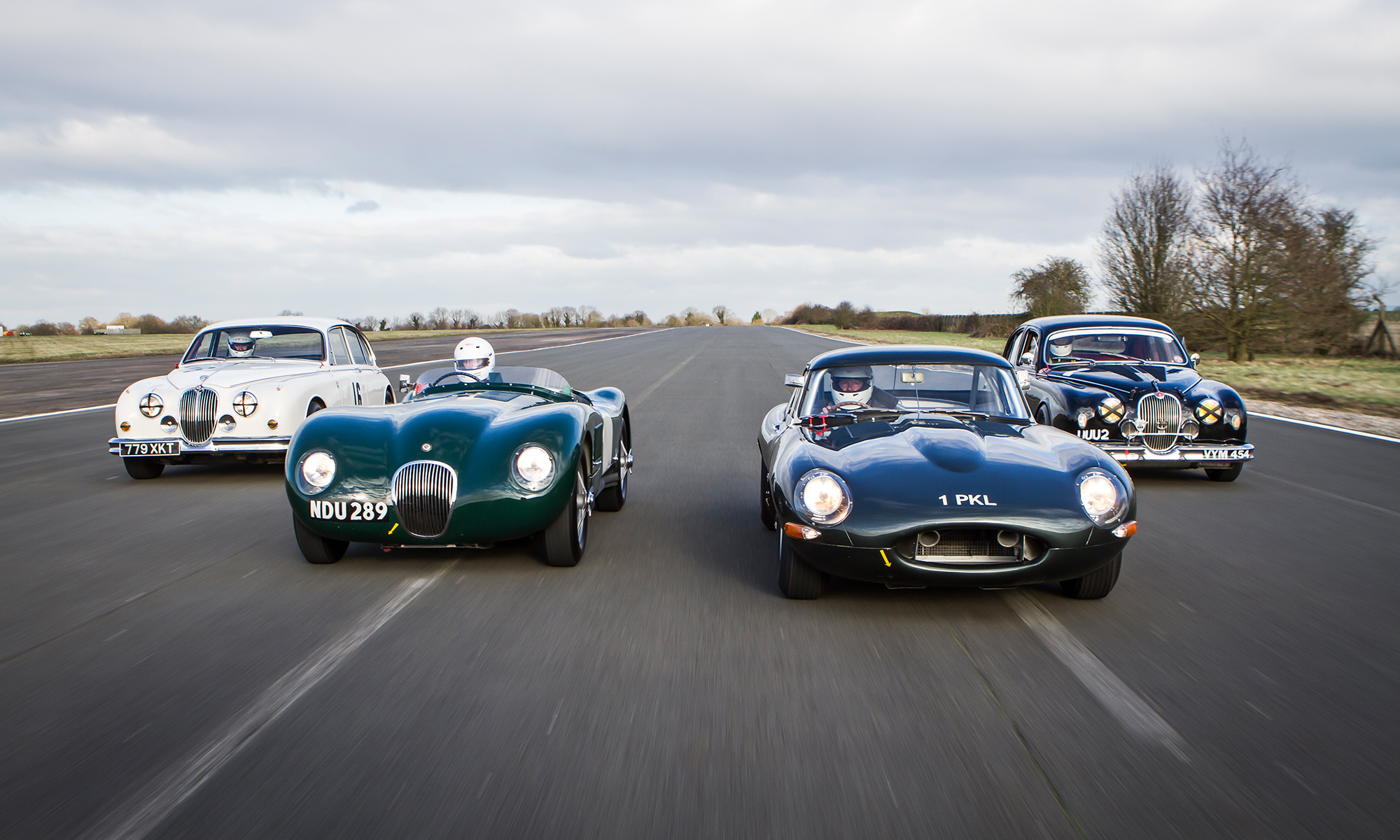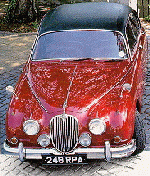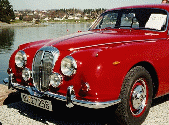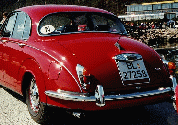The Mark IV – the 1.5/2.5/3.5 litre saloons
– 1945-49


1.5 and 2.5 litre Saloons

Mark IV Drophead
Bearing in mind that the name Mark IV was never an official factory designation for the 1945-48 cars, but has been unofficially hung on these by the afficionados ever since the early ’50’s, we will use it anyway. Mechanically these are the same as the pre-war saloon range and were produced in saloon and DHC form. The 2.5 and 3.5 engines were now produced by Jaguar, Lyons having bought the tooling from Standards, who continued to supply the 1.5 engine, making it the last Jaguar to be built with an outsider engine.
Visual differences between these and the pre-war SS Jaguar saloons are very minor. The radiator badge reads “Jaguar” with the engine size, the SS logo having been eliminated. The badge in the center of the rear bumper is a “J”, replacing the “SS”. The tires are 18″ rim diameter with wire spoke wheels, and optional Ace discs covered the spokes to give the appearance of disc wheels. The wheel knock-off hubs also say Jaguar rather than SS.
The Mark V
– 1949-51

Mark V Saloon
Produced 1948-51 as a 4 dr. saloon and a 2 dr. Drop Head Coupe with the same 2.5 and 3.5 engines as the previous model.
The Mark V is sort of a first and last car. It is the first new post-war body design, first use of pushbutton door handles (saloon) and standard sealed beam headlights (U.S. spec), first with independent front suspension and hydraulic brakes, and the last to use the pushrod engines. It is the only model to have the biplane bumpers, so called because they look like the leading edge of the wings of a biplane. These bumpers are made of seven chromed pieces each, plus supporting steel bars and top covering aprons. Saloon: The front doors are hinged at the rear but the rear doors are hinged at the front. The exterior door handles are the push button type and are in line with the chrome trim.
Drop-Head Coupe: The top is a three-position like the previous models. The doors are wood framed. The exterior door handles are the umbrella handle type.
The headlights are standard 7 inch sealed beam units for America, or 7.7 inch flat lens tribar units for all other countries. The headlight pods are welded to the front fenders and filled in with lead. Almost all Mark V’s have a pair of chromed fog lights also mounted to the front fenders, lower and closer together than the headlights. The horns are not visible. The bootlid is hinged at the bottom, and the toolkit is in the bootlid. The spare tire is in a separate compartment below the center section of the rear bumper. The tires are 16″ rim diameter with steel disc wheels painted body color and fender skirts (spats) on the rear being standard equipment.
The Mark VII
– 1950-57
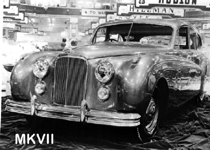
Mark VII – the first saloon car to use the XK-engine
The Jaguar MKVII was introduced October 1950.
The MKVII was the first post-war saloon. A very outstanding feature is the split front window. The chassis and gearbox are the same as in the MKV, but a number of changes were made, such as servo brakes and different shock absorbers. It was the first post-war saloon that became famous all over the world. It has a wheelbase of 10ft, overall length of 16ft 4.5 inch and a width of 6ft 1.
The MKVII is the first car with the 3,4 XK engine:
3442 cc, 160bhp at 5200 rpm,
compression 8:1 (or optional 7:1)
manual or borg warner gearbox.
Performance: 0-60 mph 13.7 secs
max speed 101 mph
A total of 20939 MKVII were built (12755 rhd and 8184 lhd)
The Mark VIIM
– 1950-57
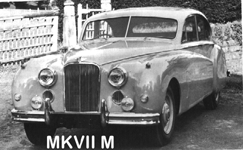
The Mark VIIM
In September 1954 the MKVII M was introduced. It had a lot of improvements/changes compared with the MKVII. At the outside the front was changed, the inset fog lamps had been moved to outboard positions on the bumper, flashing indicators on the front wings, and horn grilles replaced the fog lamps. The bumpers where also changed. There were some minor changes inside such as the flat steering wheel knob ?????? The engine was also modified: 190 bhp at 5500rpm, the gearbox ratio’s were different. One could choose between a manual gearbox, a borg warner automatic and a Laycock de Normanville overdrive.
Performance: 0-60 mph 14.3 secs
max speed 104 mph
A total of 9261 MKVII M were built (7245 rhd and 2016 lhd)
Jaguar Mark VII and VIIM on Wikipedia
The Mark VIII
– 1950-57
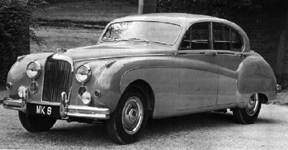
The Mark IX
October 1956 the MK VIII was introduced.
The car had been modernised. A chrome beading along the side was added, the radiator grille was different and a leaping cat was fitted, and the divided windscreen was replaced by a full width screen (a bit curved) The car had a (optional) two tone paint finish. The opening roof was standard. Inside ashtrays were fitted in the door panels and cigarette-lighters in the door-pillars. Picknick tables and a magazine rack were added. The engine was also modified: A “B” type head was fitted. This head has bigger valves. The power rating was the same as the MKVII M, but a much better performance. Most MKVIII were fitted with the Borg Warner automatic gearbox.
Performance: 0-60 mph 11,3 secs
max speed 106 mph
A total of 6332 MKVIII were built (4644 rhd and 1688 lhd)
The Mark IX
– 1950-57
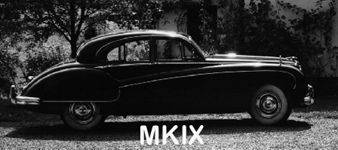
The Mark IX
In October 1958 the MKIX was presented to the public.
The MKIX looks exactly the same as the MKVIII apart from the badges on the bootlid, but the MKIX has a number of significant changes. It was the first Jaguar saloon with (standard) dunlop disc-brakes (4), and power steering. It was also the first production car with the 3.8 xk engine.
3781 cc, 220bhp at 5500 rpm,
compression 8:1 (or optional 7:1)
manual or borg warner gearbox.
Performance: 0-60 mph 11.3 secs
max speed 114 mph
A total of 10005 MKIX were built (5984 rhd and 4021 lhd)
In November 1960 the last MKIX was built, but the British Ministry of defence orderd an other 27 cars. Most of them had a separation window. Those cars are known as the MKVIII B.
Jaguar Mark IX on Wikipedia
(Text about MKVII/MKVIIM/MKVIII/MKIX by Aldert Bruinsma (afbruins@xs4all.nl with edits by JagWaugh)
The Mark 1
1955-59


The Mk 1
The Mark 2
– 1959-68
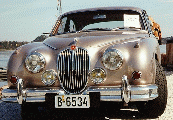
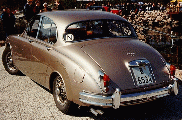

Two Mk 2s and a green 340
The Inspector Morse Mk2/Daimler V8
The Daimler V8 250
Jaguar Mark 2 and variants on Wikipedia
The Mark X
– 1961-66


The Mark X – the largest car ever made by Jaguar
The 420G
– 1966-70

The 420G – an evolution of the Mark X
Jaguar Mark X and 420G on Wikipedia
The S-type
– 1963-68
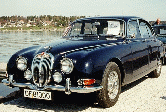
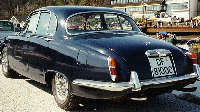
The S-type – original and a modified twin-turbo special by Lynx
Owners stories available, Alastair Lauener and Alastair Reynolds
The 420
– 1966-69

420 – the forerunner of the XJ
Jaguar 420 and Daimler Sovereign on Wikipedia
